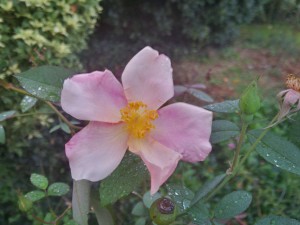
I love my roses. Something about them has stirred my imagination for far longer than I have raised them. I am not alone in my passion for these flowering shrubs. They have been in cultivation for thousands of years, and have been objects of fascination and desire for the entire time. The Empress Josephine of France was a great rosarian whose passion for roses far outlasted her marriage to Napoleon, and probably made her happier in the long run. After all, roses never demand male heirs and never left a perfectly good situation to make war on someone else’s territory.
I think I have about fifty rose bushes on my suburban plot. They are planted amidst perennials and other shrubs, rather than living in dedicated rose beds. Though I find hybrid tea-type roses very beautiful, I don’t grow a single one. Over the years I have occasionally been seduced by a comely hybrid tea, like the purple and white-striped ‘Purple Tiger’, but sooner or later they have all succumbed, mostly to cold winters.
My beds are laden with shrub roses, old fashioned roses, climbers, hybrid musks and English roses. There are even a couple whose names have been forgotten. I love those bushes despite their anonymous status.
One thing I do not indulge in is rose cosseting. The bushes get an occasional dousing with deer repellent and an equally occasional spray of baking soda/dish soap/water solution during humid weather. The latter deters black spot and powdery mildew, two fungal plagues that can defoliate roses, especially when it is hot and sticky. I wish I had the time and inclination to apply those two remedies more often. My diligence depends on my busy schedule, though I do make exceptions during those spells when Mr. Antlers, his wives and children seem bent on nipping off all the young growth.
So my roses fend for themselves and many of them have been doing so for years. Lately, though, I have had second thoughts. On a recent garden tour, I was inspired by perfect roses, their roots continuously moistened by an expensive irrigation system and their canes and leaves regularly sprayed with various chemical mixtures concocted to keep pests and diseases at bay. Those roses, each a paragon of horticultural perfection, had not a petal out of place, nor a sketchy looking leaf. No self-respecting Japanese beetle would come within half a mile of them and aphids would probably tremble at the thought of even a casual approach.

My roses can never be like that, but even I have to admit that some of them have taken a beating in recent years. Cold wind has done major damage for two successive winters, most notably in my front garden. Deer depredation, especially in the early spring when new buds are forming, has taken its toll in the same area. The roses are in recovery mode now and I am pleased that two shrubs that I thought were dead have sprouted brave new growth.
To help my recovering beauties, I have committed to regular rose feeding, something that has been a bit catch-and-catch-can in years past. I have increased the feeding schedule from once a month to every three weeks. If it ever stops raining and we revert to summer dryness, I’ll give all of them supplemental water as well. As I go around the garden doing routine chores, I will also make sure that every rose has plenty of breathing room. In some of the beds, aggressive perennials are encroaching on rose turf, which diverts moisture and nutrients away from the roots and limits the air circulation that prevents at least some fungal disease. At the same time as I remove interloping neighbors, I’ll make sure every rose has a nice collar of newspaper covered by mulch to help retain moisture in the soil.
Those efforts have already begun, and while it is too soon to see dramatic results, the roses seem to look perkier. The ultimate goal is lots of beautiful blooms this year, plus strong growth that will help see the plants through next winter. Good roses—and I always buy good roses—are an investment and this is my way of preserving beauty and a return on that investment.
“A rose is a rose is a rose,’ wrote Gertrude Stein early in the twentieth century. She may have been right at the time, but a rose in my garden will never be quite like a rose in a show garden. But it can be the best possible version of a “regular garden” rose.
